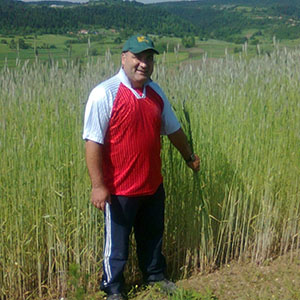Organic spelt production systems: Productive and financial performance in three orographic regions

Accepted: 9 May 2022
HTML: 57
All claims expressed in this article are solely those of the authors and do not necessarily represent those of their affiliated organizations, or those of the publisher, the editors and the reviewers. Any product that may be evaluated in this article or claim that may be made by its manufacturer is not guaranteed or endorsed by the publisher.
A two-year field trial was conducted to study the effects of biohumus, biofertiliser, and soil conditioner application on spelt grain yield in different regions (plain, hilly, and mountainous regions) in Serbia. An analysis of economic efficiency indicators of spelt production in organic farming systems was also performed. The field experiment had a randomised complete block design with three replicates in each of the three regions. One winter spelt cultivar was also studied. The largest differences in spelt yield compared to control were found in the plain region in the biohumus + biofertiliser treatment (28.0%) and the hilly region in the organic fertiliser + zeolite treatment (28.8%). The differences in grain yield between control and treatment conditions in the mountain region were insignificant. Analysis of the economic effects of organic spelt production found a significantly lower gross margin in treatments with expensive organic fertilisers (3955.05 and 1104.75 € ha–1) than the control (5094.31 and 1833.85 € ha–1), leading to the conclusion that their application was not economically justified despite the increases in grain yield. The highest production costs (3569.71 € ha–1) were observed in treatments in the hilly region, resulting in the lowest benefit-cost ratio (0.1), while the greatest benefit-cost ratio was recorded in treatments in the mountainous region (2.1). Following the economic analysis results, a significant negative correlation between the benefit-cost ratio and the total production costs (r= –0.91**) was determined and a positive correlation between the gross margin and grain yield (r=0.66*). These results lead to the conclusion that the management strategy of spelt production in organic farming systems should be harmonised with the soil and agro-ecological characteristics of the region and directed at decreasing the costs and share of external inputs. In this case, organic spelt production can be economically profitable.
Highlights
- Organic fertilisers and soil conditioners affect spelt grain yield.
- The analysis of the economic effects of organic spelt production concluded that fertiliser application was not economically justified despite the increases in grain yield.
- Treatments in the plain region displayed the best production results compared to mountain region treatments, but these did not have the best benefit-cost ratio.
- Knowledge of production costs is an important element in improving the economic efficiency of organic farming systems.
How to Cite

This work is licensed under a Creative Commons Attribution-NonCommercial 4.0 International License.
PAGEPress has chosen to apply the Creative Commons Attribution NonCommercial 4.0 International License (CC BY-NC 4.0) to all manuscripts to be published.

 https://doi.org/10.4081/ija.2022.2025
https://doi.org/10.4081/ija.2022.2025



